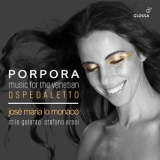Das 1528 gegründete Ospedaletto war das kleinste der vier berühmten venezianischen Waisenhäuser, die für besonders niveauvolle musikalische Darbietungen bekannt waren. Nicola Porpora wirkte dort von 1743 bis 1747, wo er der Sängerin Angiola Moro begegnete, für die er die Solopartien schuf, welche die Mezzo-Sopranistin Josè Maria Lo Monaco auf diesem Album singt. Und diese sorgt für viel Begeisterung. Mit ihrem bestechend warmen und dunkel leuchtenden Timbre, einer wendigen, trotz ihres Brokat-Charakters schlanken Stimme und mit einer sehr natürlichen Emphase gibt sie den Vokalwerken sehr viel Charakter.
Das Ensemble Stile Galante liefert eine Darstellung, die nicht nur die allseitige spielerische Kompetenz und musikwissenschaftliche Sorgfalt unter Beweis stellt, sondern in ihrer Klangtiefe und -vielfalt und dem wohltuend unaufgeregten Vortrag sehr erfreut. Bei immer transparenter, Instrumentierung kann das kleine besetzte Ensemble unter der umsichtigen Leitung von Stefano Aresi eine barocke Üppigkeit vermittelt, die gänzlich eigenständig ist.
Porporas Spezialisierung als Vokalkomponist und -lehrer war so groß, dass er den virtuosen Cellisten Costanzi hinzuzog, um sicherzustellen, dass er idiomatisch für Streicher schrieb. Dennoch erinnert das Cellokonzert an Porporas Vokalmusik, und das nicht nur in den lyrischen Adagio-Sätzen. Auch die schnellen virtuosen Sätze erinnern an die Anforderungen, die Porpora seinen Sängern abverlangte. Agnieszka Oszanca am Cello hat kein Problem, mit dunkel-warmem oder auch berückend hellem Celloklang diese ausdrucksstarke und originelle Musik hervorragend zu vermitteln.
Founded in 1528, the Ospedaletto was the smallest of the four famous Venetian orphanages, which were known for their particularly sophisticated musical performances. Nicola Porpora worked there from 1743 to 1747, where he met the singer Angiola Moro, for whom he created the solo parts sung by the mezzo-soprano Josè Maria Lo Monaco on this album. And she creates a lot of enthusiasm. With her captivatingly warm and darkly luminous timbre, an agile voice that is slender despite its brocade character and with a very natural emphasis, she gives the vocal works a great deal of character.
The Stile Galante ensemble delivers a performance that not only demonstrates all-round playing competence and musicological care, but is also very pleasing in its depth and variety of sound and a pleasantly unagitated performing. With continuously transparent instrumentation, the small ensemble under the careful direction of Stefano Aresi is able to convey a baroque opulence that is entirely its own.
Porpora’s specialization as a vocal composer and teacher was so great that he called in the virtuoso cellist Costanzi to ensure that he wrote idiomatically for strings. Nevertheless, the cello concerto is reminiscent of Porpora’s vocal music, and not only in the lyrical Adagio movements. The fast virtuoso movements are also reminiscent of the demands Porpora made on his singers. Agnieszka Oszanca on the cello has no problem conveying this expressive and original music with a dark, warm or enchantingly bright cello sound.
























